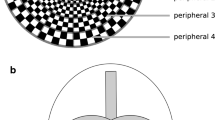Abstract
Recent research suggested that transcranial direct current stimulation (tDCS) can affect visual processing and that it can be useful in visual rehabilitation. Nevertheless, there are still few investigations on the subject. tDCS selectivity and the extent of its outcomes on visual perception are still to be assessed. Here, we investigate whether central and peripheral visual fields are equally affected by tDCS. We also tried to reproduce a previous work that has evaluated tDCS effects on the central visual field only (Kraft et al. 207:283–290, 2010). Fifteen healthy subjects participated in this randomized repeated-measure design study and received 1.5-mA anodal, cathodal and sham stimulation in different sessions, while performing 10-2 and 60-4 protocols in an automated perimeter. Anodal tDCS significantly decreased thresholds, but was limited to the most eccentric regions of the visual field measured (60°). This suggests that tDCS might be used for rehabilitation of peripheral visual field losses. We did not replicate the excitatory tDCS effect in the central visual field as previously reported by another group. Instead, we observed a trend toward an inhibitory (yet not statistically significant) effect of anodal tDCS on the central field. This might be explained by methodological differences. These results highlight that although tDCS is a technique with a low focality in the spatial domain, its effects might be highly focal in a functional domain. When taken together with previous findings, this also suggests that tDCS may have a differential effect on different retinotopic areas in the brain.



Similar content being viewed by others
References
Accornero N, Votti P, La Riccia M, Gregori B (2007) Visual Evoked potentials modulation during direct current cortical polarization. Exp Brain Res 178(2):261–266
Antal A, Nitsche MA, Paulus W (2001) External modulation of visual perception in humans. Neuroreport 12:3553–3555
Antal A, Kincses TZ, Nitsche MA, Bartfai O, Paulus W (2004a) Excitability changes induced in the human primary visual cortex by transcranial direct current stimulation: direct electrophysiological evidence. Investig Ophthalmol Vis Sci 45:702–707
Antal A, Varga ET, Nitsche MA, Chadaide Z, Paulus W, Kovacs G, Vidnyanszky Z (2004b) Direct current stimulation over MT +/V5 modulates motion aftereffect in humans. Neuroreport 15:2491–2494
Bikson M, Rahman A (2013) Origins of specificity during tDCS: anatomical, activity-selective, and input-bias mechanisms. Front Hum Neurosci 7:1–5
Bikson M, Rahman A, Datta A (2012) Computational models of transcranial direct current stimulation. Clin EEG Neurosci 43(3):176–183
Bolognini N, Olgiati E, Rossetti A, Maravita A (2010a) Enhancing multisensory spatial orienting by brain polarization of the parietal cortex. Eur J Neurosci 31:1800–1806
Bolognini N, Fregni F, Casati C, Olgiati E, Vallar G (2010b) Brain polarization of parietal cortex augments training-induced of visual exploratory and attentional skills. Brain Res 1349:76–89
Costa TL, Nagy BV, Barboni MTS, Boggio PS, Ventura DF (2012) Transcranial direct current stimulation modulates human color discrimination in a pathway specific manner. Front Psychiatry 3:1–9
Costa TL, Hamer RD, Nagy BV, Barboni MT, Gualtieri M, Boggio PS, Ventura DF (2015a) Transcranial direct current stimulation can selectively affect different processing channels in human visual cortex. Exp Brain Res. doi:10.1007/s00221-015-4199-7
Costa TL, Costa MF, Magalhães A, Rêgo GG, Nagy BV, Boggio PS, Ventura DF (2015b) The role of early stages of cortical visual processing in size and distance judgment: A transcranial direct current stimulation study. Neurosci Lett 588:78–82
De Valois KK (1977) Spatial frequency adaptation can enhance contrast sensitivity. Vis Res 17:1057–1065
Gandiga PC, Hummel FC, Cohen LG (2006) Transcranial DC stimulation (tDCS): a tool for double-blind sham-controlled clinical studies in brain stimulation. Clin Neurophysiol 117(4):845–850
Heijl A, Lindgren G, Olsson J (1989) The effect of perimetric experience in normal subjects. Arch Ophthalmol 107:81–86
Iuculano T, Kadosh RC (2013) The mental cost of cognitive enhancement. J Neurosci 33:4482–4486
Kraft A, Roehmel J, Olma M, Schmidt S, Irlbacher K, Brandt S (2010) Transcranial direct current stimulation affects visual perception measured by threshold perimetry. Exp Brain Res 207:283–290
Lapenta OM, Minati L, Fregni F, Boggio PS (2013) Je pense donc je fais: transcranial direct current stimulation modulates brain oscillations associated with motor imagery and movement observation. Front Hum Neurosci 7:246
Miranda PC, Lomarev M, Hallett M (2006) Modeling the current distribution during transcranial direct current stimulation. Clin Neurophysiol 117:1623–1629
Olma MC, Kraft A, Roehmel J, Irlbacher K, Brandt SA (2011) Excitability changes in the visual cortex quantified with signal detection analysis. Restor neurol Neurosci 29(6):453–461
Papp A, Kis K, Németh J (2001) conversion formulas between automated-perimetry indexes as measured by two different types of instrument. Ophthalmologica 215:87–90
Peters MA, Thompson B, Merabet LB, Wu AD, Shams L (2013) Anodal tDCS to V1 blocks visual perceptual learning consolidation. Neuropsychologia 51:1234–1239
Plow EB, Obretenova SN, Halko MA, Kenkel S, Jackson ML, Pascual-Leone A, Merabet LB (2011) Combining visual rehabilitative training and noninvasive brain stimulation to enhance visual function in patients with hemianopia: a comparative case study. PM&R 3:825–833
Plow EB, Obretenova SN, Fregni F, Pascual-Leone A, Merabet LB (2012a) Comparison of visual field training for hemianopia with active versus sham transcranial direct cortical stimulation. Neurorehabil Neural Repair 26:616–626
Plow EB, Obretenova SN, Jackson ML, Merabet LB (2012b) Temporal profile of functional visual rehabilitative outcomes modulated by transcranial direct current stimulation. Neuromodulation 15:367–373
Sack AT, Cohen Kadosh R, Schuhmann T, Moerel M, Walsh V, Goebel R (2009) Optimizing functional accuracy of TMS in cognitive studies: a comparison of methods. J Cognit Neurosci 21:207–221
Spiegel D, Byblow W, Hess RF, Thompson B (2013) Anodal transcranial direct current stimulation transiently improves contrast sensitivity and normalizes visual cortex activation in individuals with amblyopia. Neurorehabil Neural Repair 27:760–769
Wang B, Yamamoto H, Wu J, Ejima Y (2013) Visual field maps of the human visual cortex for central and peripheral vision. Neurosci Biomed Eng 1(2):102–110
Author information
Authors and Affiliations
Corresponding author
Rights and permissions
About this article
Cite this article
Costa, T.L., Gualtieri, M., Barboni, M.T.S. et al. Contrasting effects of transcranial direct current stimulation on central and peripheral visual fields. Exp Brain Res 233, 1391–1397 (2015). https://doi.org/10.1007/s00221-015-4213-0
Received:
Accepted:
Published:
Issue Date:
DOI: https://doi.org/10.1007/s00221-015-4213-0




